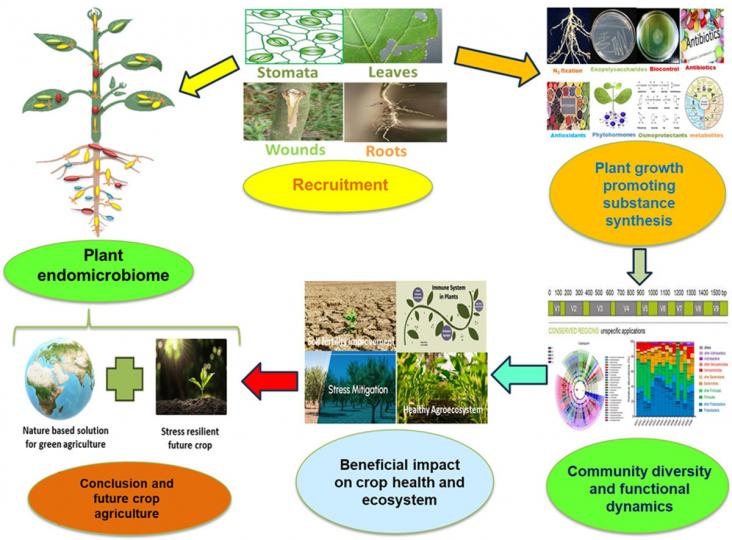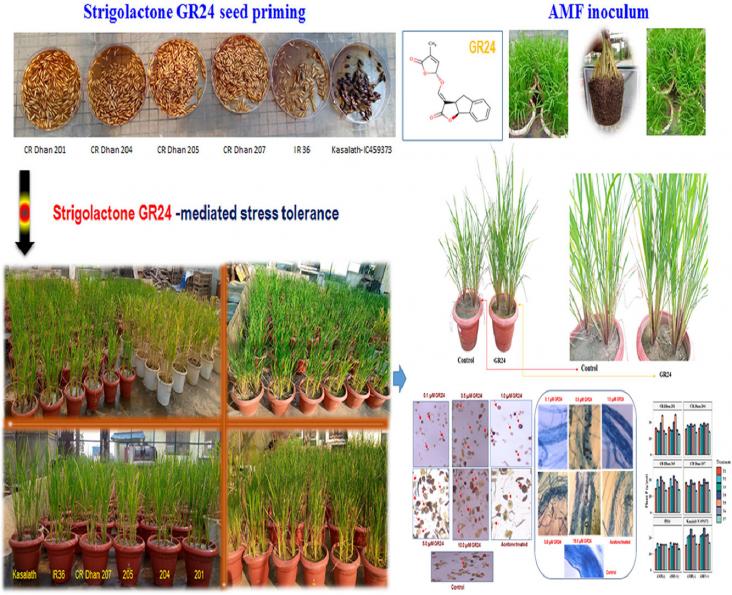
Plants have a microbiome, a diverse community of microorganisms, including bacteria, fungi, and viruses, living inside and on their tissues. This review article contains deeper insight in endomicrobiome related research work in last years, recruitment, niche development, nutrient dynamics, stress removal mechanisms, bioactive services in plant health development, community architecture and communication, and immunity interplay in producing stress resilient future crop.

Strigolactones (SLs) are a new class of plant hormones that play a significant role in regulating various aspects of plant growth promotion, stress tolerance and influence the rhizospheric microbiome. GR24 is a synthetic SL analog used in scientific research to understand the effects of SL on plants and to act as a plant growth promoter.
High soil temperature is a key environmental factor threatening food production in hot climates, especially in the era of global warming. Additionally, high soil evaporation under sunlight leads to significant water loss. Currently, there is a lack of effective and feasible soil management methods during hot seasons. This paper presents a soil-cooling strategy based on radiative cooling mulch.
A discussion on how well Emojis reflect biodiversity, and how this should be improved to contribute to public engagement and communication.
Illegal Wildlife Trade (IWT) is among the most lucrative illegal industries in the world and is a significant driver of biodiversity decline. This paper outline the basics of IWT and discuss its cascading consequences on environments, human lives and communities, national stability, and the economy.
A sustainable future requires securing of the fundamental relationship between humans and biodiversity. This article highlights the importance of tapping into Indigenous and local knowledge for the conservation of biodiversity
A study published by Mukhopadhyay et al., 2023 investigates the long-term impact of subsurface drainage (SSD) on soil quality restoration and sugarcane productivity in waterlogged saline Vertisols in India. By using soil and water samples together with a farmer field survey, the authors showed that SSD significantly reduced soil salinity and improved various soil properties, leading to increased sugarcane yields by up to 585.5%. Farmers' perceptions indicated that SSD technology could substantially improve soil conditions and crop yields, and large-scale adoption of the technology will support the Sustainable Development Goals related to Land, No Poverty, and Zero Hunger in saline soils of India.
This research emphasizes the importance of recognizing diverse perspectives and values in defining and conserving forests, highlighting the dominance of Western institutions in shaping global discourses on forest conservation. The study underscores the need to incorporate Indigenous and local perspectives in defining forest terms to address recognition and procedural inequities, aligning with the objectives of the International Day of Indigenous Peoples to promote cultural diversity and inclusivity in conservation practices.
Knowledge of biological diversity is a major source of innovation. Collective intellectual property of traditional knowledge by Indigenous peoples and local communities is an important source of innovation and product development. This article investigates collective intellectual property systems on the traditional knowledge of Aspalathus linearis, also known as rooibos—an endemic plant from South Africa which is the basis of an important herbal tea industry. The article discusses how collective action and self-organization can generate collective intellectual property systems; indigenous peoples and local communities can develop these systems to protect their IP; how these systems can promote social justice and a more equitable distribution of benefits but can be sources of dispute between socio-economic groups and communities and can reproduce historical inequalities and power asymmetries.
The paper addresses the urgent need to halt species extinction by proposing a global prioritization strategy for conservation, leveraging individual population data to identify priority areas that significantly enhance the long-term persistence of threatened terrestrial mammal species, thus providing a more effective and efficient approach for meeting the targets outlined in the Global Biodiversity Framework.
